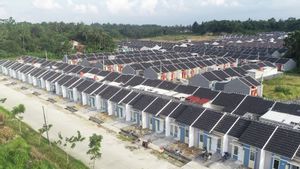JAKARTA - Indonesia is a country prone to earthquakes and tsunamis. Records about earthquakes have even existed since time immemorial. Nusantara which is in the path of the ring of fire is the answer. The Flores East Nusa Tenggara (NTT) earthquake and tsunami in 1992, for example.
The tsunami that started with an earthquake measuring 7.5 on the Richter scale destroyed Flores. Thousands of casualties fell. Hundreds of places of worship were destroyed. The Flores people later remember this event as 'Doomsday at noon'. Indonesia's footprint as the epicenter of the earthquake is present in many works and travel notes of world celebrities.
One of those who recorded it was Lieutenant Governor of the Dutch East Indies, Thomas Stamford Raffles (1811-1816). During his leadership in Tanah Harapan (Java), Raffles realized how earthquake-prone the archipelago was. Raffles once wrote about the big earthquake in Batavia in 1699. The earthquake made Batavia's environment even more unhealthy.
On another occasion, Raffles also mentioned the earthquake as one of the reasons why many popular temples in the archipelago were damaged. For him, only large-scale tectonic forces are capable of folding the terraces of the temple buildings. The floor of the temple terrace is curved until stupa stones fall and scatter on the terrace floor, like the image of Borobudur when it was initially rediscovered by Raffles.
“In addition to their statement regarding the two ruins of ancient objects, Brambanan (Prambanan) and Boro Bodo (Borobudur) are magnificent objects as masterpieces. Some of the buildings are covered in beautiful plants. However, the destruction was slowly occurring in several places. The shape is symmetrical and regular, many interesting characters can be seen on the site and the reliefs that exist, which are full of ornaments and arouse a sense of curiosity nowadays, but they have not been studied, sketched and explained much, "said Thomas Stamford Raffles in his masterpiece, The History of Java (1817). ).

In contrast to Raffles. Naturalist Alfred Russel Wallace, on his way to the archipelago, recorded many earthquakes outside Java, to be precise in the eastern part of the archipelago. Timur Nusantara is called by Alfred as the area most prone to earthquakes. This observation was written in the notes on his trip to Manado, Celebes (Sulawesi) in 1858. Alfred often finds low-scale earthquakes that are strong enough to shake buildings.
In that context, Alfred even paid attention to the behavior of the local natives when an earthquake hit the area. The earthquake, said Alfred, was able to create both fear and amusement among the native people. One side, Alfred saw that the earthquake could kill many people. On the other hand, the local indigenous people consider the earthquake to be a game that requires them to race out of the house quickly.
“There was a mixture of fear and amusement during the earthquake. We were afraid of a stronger vibration which could cause the houses to collapse on us. Or what I fear more is that the earthquake will cause landslides. However, at the same time, it was hilarious to see all of us scattering outside every time there was a light tremor, then immediately came back in, "wrote Alfred Russel Wallace in his masterpiece, Kepulauan Nusantara (2009).
1992 Flores earthquake and tsunami
It is possible that Alfred Russel Wallace referred to the earthquake as a combination of tragedy and comedy. This assumption is because Alfred explored Indonesia in the period 1854-1862. His statement would be different if he directly felt the Flores earthquake and tsunami on December 12, 1992. The earthquake with such a large magnitude shook the Flores sea and brought deep sorrow to all its citizens.
The Meteorology and Geophysics Agency recorded that the magnitude of the earthquake was at 6.8 on the Richter scale. However, the geophysical institute Institut de Physique du Globeyang based in Strasbourg, France, recorded the magnitude reaching 7.5 SR. The Flores earthquake destroyed four districts (Sikka, Ngada, Ende, and Flores Timur). After that, the big waves of the Tsunami hit small islands and several fishing villages. Noted, the death toll from the incident reached more than 2,400 people.
Apart from the death toll, around 18 thousand houses were destroyed, 113 schools were destroyed, 211 offices were severely damaged, 120 places of worship (mostly churches) were unusable. Five main streets were also completely paralyzed. These facts made the Flores earthquake and tsunami the earthquake with the largest casualties in history, prior to the Aceh earthquake (2004) and the Yogyakarta earthquake (2006).

“Maumere, the heart and capital of Sikka Regency, is suffering the worst. More than 10 thousand houses were destroyed. The city has a population of about 20 thousand inhabitants. The pulse of economic activity there for the time being can be said to be in a coma, although that does not mean it is dead. Just look at how the old market near the port was destroyed. The shopping areas are only rubble and buildings collapsed. The BRI office, hospital, and all other government buildings were severely damaged, ”said Wahyu Muryadi and Zed Abidien in their article in Tempo Magazine entitled Disaster and Aid on the Island of Flowers (1992).
Maumere is practically a dead city. The earthquake disaster got worse because afterwards the impact of the tsunami waves swept across Babi Island and Pamana Besar Island. The tsunami also swept across the faces of two small islands with a total population of about two thousand people. Almost all residents are sucked in by water. Not only that, the great tsunami waves were still creeping as far as 300 meters to Maumere beach and crashing into the fishing village.
“Maumere is suffering the worst. About 1,100 people who died came from this poor fishing area. And hundreds of others were seriously injured. To the extent that the hospital in Maumere was forced to lay the flooded patients in the hallways of the wards, ”wrote a report by Tempo magazine entitled Apocalypse is Named an Earthquake (2018).
As a result, the survivors chose to build emergency tents in the nearby hills. Moreover, after the earthquake and tsunami disaster, many residents experienced deep trauma. Rescuers moved fast. The bodies that were scattered were immediately buried. One person buried in one burrow.
There is also a hole filled by two to three people. Even then, the burial hole cannot be dug too deep, because only half a meter has been dug, salt water has filled the hole. The event was later remembered as the Apocalypse at noon. Immediate grief enveloped all of Indonesia.
The Flores people, who should have welcomed Christmas 1992 with joy, actually celebrated Christmas in the sorrow of losing their relatives and livelihoods. To commemorate this event, the metal band from Surabaya, Power Metal, briefly summarized the sadness of the 1992 Flores earthquake and tsunami in a song entitled Timur Tragedi (1993).
East of tragedy
You are blind
Destroy property and property
East of tragedy
What are you a sign
Sometimes nature dares to be angry.
* Read other information about HISTORY OF NUSANTARA or read other interesting writings from Detha Arya Tifada.
MEMORY OtherThe English, Chinese, Japanese, Arabic, and French versions are automatically generated by the AI. So there may still be inaccuracies in translating, please always see Indonesian as our main language. (system supported by DigitalSiber.id)









